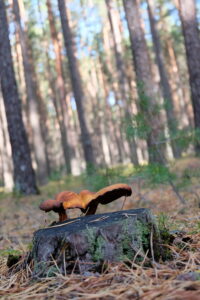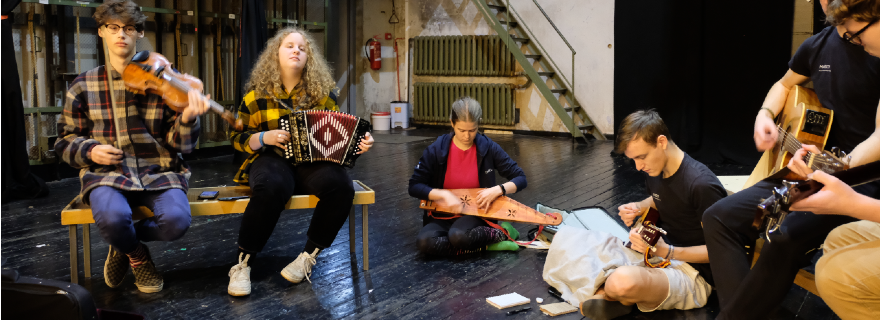Uncertain Heritage: Musicking in Estonia
Estonians often refer themselves as a “small Singing Nation”. Siyun Wu studies music heritage and its impact on Estonian society. She notes that in searching for their musical past, music practitioners embrace uncertainty in a way that is strikingly similar to another favourite pastime: finding mushrooms.
During my research on music heritage in Estonia, I was struck by a parallel between musical practice and another favorite Estonian pastime: mushrooming. Why? These two practices both require a particular enskilled attention, shot through with uncertainty, surprise, and improvisation. The mushrooming metaphor helps us see how Estonian musicians relate to their national music heritage and practice it. Let me start with the experience and skill of finding mushrooms.


Mushrooming
The Estonian term seenelkäik literally means “mushroom-going”. It is often translated by my informants as “mushrooming” – an activity that they encompassed much more than picking and harvesting mushrooms. I started to learn how to “mushroom”, after accidentally coming across this activity multiple times when I followed people to music concerts, festivals and workshops. While observing, imitating and developing the skills needed for this activity, I also started to understand its magic.
Deep into the wild woods, mushrooming means searching through various kinds of uncertainty. Such as when and where a mushroom might appear; if it is healthy and safe. And also risks, such as getting lost, finding unknown species, and most challengingly: making mistakes in the identification of a mushroom. To safely find a small, and hidden mushroom, mushroomers have to search hard. They need to observe, touch, smell, and listen; to notice moisture, texture, colours, lights, layers, changes and movements. They are pushed to activate as many sensory stimuli as possible to attend to their surroundings. In such an endeavor of keeping on searching with utmost attention and courage, flexibly and persistently, mushroomers enjoy the possibility of encountering a mushroom as much as the encounter itself.
Getting lost and inspired in the woods. Treescape by Estonian visual artist and music photographer Kaupo Kikkas, exhibition in Gallery Untitle, Netherlands, videoed by author (2020)
Musicking the Uncertain Past
Strikingly, many practitioners of traditional music in Estonia also engage in the practice of mushrooming. When following both of these practices, I came to see that mushrooming is a rather adequate metaphor for the ways their musical practice. Coined by Christopher Small as an action to describe taking part in music in any capacity from composing and performing, listening to, dancing along, musicking reveals the process of music production under relations that are constructed musically as well as socially. Estonian music practitioners, as I will describe below, have a rather uncertain relationship with heritage. And it is from this uncertainty, and the particularities of their kind of music, that they are musicking in such a way that is like mushrooming.
Folk club Maatasa in Tartu is one such group practicing traditional music. When I first met people at Maatasa, I was struck by how they started working with a laptop instead of with a teacher, a repertoire or their instruments – all modes that I had become used to when learning to play the piano and the Chinese flute. As much of the Estonian traditional music has not been taught (structurally in the public sphere) for a long time, for Maatasa practitioners what could be their traditional music is rather “unclear” or “lost”, something needed to be searched for like mushrooms in the forest. And the forest they turn into a digital archive that holds some audio recordings. To learn a tune from an archive audio recording, which is considered to be the most “authentic” and often only direct, evidence from the past, Maatasa practitioners need to “mushroom”, very attentively and continuously, in uncertain sound, skills, standards and ideals.
Since traditional Estonian music does not have a clearly marked notation like in classical music, finding the right note is like searching for a mushroom hidden from apparent sight and hard to identify. Maatasa musicians pick each note out of layers of sound (the music itself, recording of background noise and the device), verse by verse, version by version across players and regions. They then seek the closest possible match to this note in each of their own and many newly salvaged “traditional” instruments. To do so, Maatasa practitioners fully count on their ears.
Expanding a note to the whole tune, they then search together for ways to play. In the Chinese folk music that I myself grew up with, students generally learn from their masters and follow structured skill progression and ideals of the school each master affiliates to. For Maatasa practitioners, however, there are no exact ways nor standard systems to guide their training, practice, and performance. Playing the “lost” tune with the “lost” instrument, Maatasa musicians apply techniques they know from similar instruments, guess according to their experiences in other music genres, and experiment when practicing with their instruments. They thus explore the heritage instrument creatively to bring alive the tune from the past.
Mushrooming Heritage Possibilities
Heritage is often perceived as something significant, valuable and yet, as Rodney Harrison describes, uncertain, vulnerable, at-risk and in need of safeguarding, conservation, preservation and care. For Estonians, the past is not only a foreign country but also an unclear, uncertain one. For centuries, Estonians referred to themselves simply as “the country folk” farming under successive foreign rules, most profoundly by the German and Russian Empires. Even after a sense of Estonianness with a distinct desire for its own national culture emerged in the mid-19 century, the country was repeatedly contested, invaded and occupied until it re-gained independence in 1991, after which it also got swiftly swirled into various globalising trends based on cultures of “the West”.
Despite different kinds and levels of uncertainty underlying in their national culture as a small country, Estonian practitioners like Folk club Maatasa head-on, search, and (re)create the musical past that they connect to as Estonians. Musicking uncertain heritage as if mushrooming in the woods, through their very attempts at searching and improvising, they actively invent and construct Estonian music heritage and its possible continuity, and by doing so, harvest their connection to music, each other, and the nation.



0 Comments
Add a comment